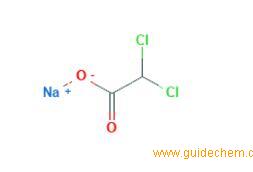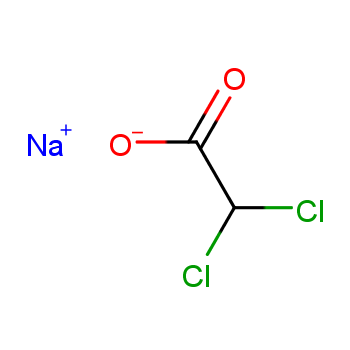 |
Sodium Dichloroacetate is the sodium salt of dichloroacetic acid with potential antineoplastic activity. Dichloroacetate ion inhibits pyruvate dehydrogenase kinase, resulting in the inhibition of glycolysis and a decrease in lactate production. This agent may stimulate apoptosis in cancer cells by restoring normal mitochondrial-induced apoptotic signaling. A derivative of acetic acid that contains two CHLORINE atoms attached to its methyl group [1].

Sodium dichloroacetate (DCA) is a mitochondrial pyruvate dehydrogenase kinase inhibitor, and is an orally absorbable small molecular compound for MELAS syndrome, and children with congenital lactic acidosis and other diseases that are treated in the clinic. Recent studies had found that DCA acts as a potential vasoprotective agent by inhibiting PDK2 and reducing coronary endarterium proliferation. Further, DCA promotes brain regeneration after cerebral ischemia, which indicates that DCA might play an important role in VD [2].
Sodium dichloroacetate (DCA) is a mitochondrial pyruvate dehydrogenase kinase inhibitor, and has been shown to display vasoprotective effects in chronic ischemic stroke. Hui Zhao etc. evaluated the therapeutic effect of DCA on vascular dementia (VD) and endothelial progenitor cell (EPC)-mediated angiogenesis. Observations suggest that prolonged DCA administration might be beneficial in treating VD [3].
The drug sodium dichloroacetate (DCA) has been investigated as a novel metabolic therapy for various cancers since 2007 when Bonnet et al published a combined in vitro/in vivo rat study demonstrating the efficacy of DCA in treating human lung, breast and brain cancers by inhibition of mitochondrial pyruvate dehydrogenase kinase. Stacpoole et al had previously published multiple studies involving DCA for the treatment of congenital lactic acidosis, which is composed of a collection of inherited mitochondrial diseases. These studies established the safety profile of oral DCA in humans. DCA was discovered to be a safe drug with no cardiac, pulmonary, renal or bone marrow toxicity[4]. The most serious common side effect consists of peripheral neuropathy, which is reversible. Delirium has been reported, and is reversible after discontinuation of DCA. Asymptomatic and reversible liver enzyme elevation has been reported in a small percentage of patients. The prior work in congenital lactic acidosis has enabled the rapid progression of DCA into the cancer clinic. Four reports have now been published of cancer clinical trials using DCA, indicating a growing recognition of the potential usefulness of DCA. However, these trials treating late stage patients, have only been able to report on treatment for relatively short time periods.
In the initial 2007 paper by Bonnet et al, it was reported that DCA reduced mitochondrial membrane potential resulting in selective apoptosis in cancer cells. The mechanism identified was inhibition of aerobic glycolysis (the Warburg effect) and activation of mitochondrial potassium ion channels. Further investigation of DCA confirmed anti-cancer activity in several cancer types including colon, prostate, ovarian, neuroblastoma, lung carcinoid, cervical, endometrial, cholangiocarcinoma, sarcoma and T-cell lymphoma. Other antineoplastic actions of DCA have also been suggested. These include angiogenesis blockade, changes in expression of HIF1-α, alteration of pH regulators V-ATPase and MCT1, and other cell survival regulators such as PUMA, GLUT1, Bcl2 and p53. However, in the quest for cytotoxic activity, many in vitro reports use concentrations of DCA that are unlikely to be achieved clinically. Some studies have used restricted concentrations and found DCA to be cytostatic rather than cytotoxic, but able to enhance apoptosis with other agents. In the report of successful in vivo DCA treatment of breast cancer, Sun et al found DCA to be cytostatic, inhibiting proliferation without increasing apoptosis. DCA was able to significantly reduce metastatic burden in the lungs of rats in a highly metastatic in vivo model of breast cancer. This suggests a new role for DCA as a cancer stabilizing agent, similar to an anti-angiogenic therapy. However, to the authors’ knowledge, no human data has yet been published supporting the use of DCA for long-term maintenance of stable disease [4].
[1] https://pubchem.ncbi.nlm.nih.gov/compound/Sodium-dichloroacetate
[2] Hong, D. K., Kho, A. R., Choi, B. Y., Lee, S. H., Jeong, J. H., Lee, S. H., et al. (2018). Combined treatment with dichloroacetic acid and pyruvate reduces hippocampal neuronal death after transient cerebral ischemia. Front. Neurol. 9:137. doi: 10.3389/fneur.2018.00137
[3] Hui Zhao, Junqin Mao, Yuan Yuan, Jingjing Feng, Hao Cheng, Guorong Fan, Yuefan Zhang and Tiejun Li, Sodium Dichloroacetate Stimulates Angiogenesis by Improving Endothelial Precursor Cell Function in an AKT/GSK-3β/Nrf2 Dependent Pathway in Vascular Dementia Rats, Front. Pharmacol., 17 May 2019 | https://doi.org/10.3389/fphar.2019.00523
[4] Akbar Khan, Douglas Andrews, Anneke C Blackburn, Long-term stabilization of stage 4 colon cancer using sodium dichloroacetate therapy, World J Clin Cases 2016 October 16; 4(10): 336-343
 |